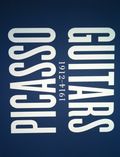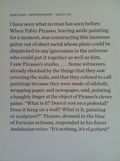25 Apr Telluride Off-season: Another bite at the Big Apple
 Telluride Inside… and Out spent last Friday and Saturday in New York City.
Telluride Inside… and Out spent last Friday and Saturday in New York City.
On Friday, we returned to the Metropolitan Museum of Art to see "Cezanne's Card Players," a fitting exhibit, so it would seem, for this high-stakes moment in history. Then again Cezanne's stoical models, all tradesman and employees of his family estate, appear totally content with their lot in life. Not so much like today.
We need to look further back in history to the 17th-century genre paintings of card players for our metaphor, images in which lusty, drooling drunks dominate. (The Met supplies example of his antecedents in the Cezanne show.) In his card players, Cezanne's emphasis is on rugged individualism and living in the moment, not on gambling and its attendants: greed and violence.
Sticking with the theme – magic wrested from the mundane – our next stop was "Rooms With a View: The Open Window in the 19th Century." The show's 30 some small paintings and an equal number of works on paper explore the open window, a symbol of yearning, a favorite motif of certain Romantic painters from Germany, Denmark, France, and Russia around the time of the Napoleonic Wars, 1810 – 1812. Like the Cezannes, the focus here is on life's daily small pleasures, on being rather than on doing, on solitary acts by self-aware people and singular light. Unlike Cezanne, "Rooms With a View" features names you have never heard of – C. D. Friedrich, C. G. Carus, G. F. Kersting, Adolph Menzel, C. W. Eckersberg, Martinus Rørbye, Jean Alaux, and Léon Cogniet – but won't soon forget. (Menzel, one of the stars of the show, opens a window on Impressionism with his focus on light defining loosely rendered space.)
 Saturday's return trip to town was in part about a reunion with former Telluride locals Sidney and Monique Lazard. In part, Clint and I craved another juicy bite out of the Big Apple, more food for thought. There was also a desire for symmetry.
Saturday's return trip to town was in part about a reunion with former Telluride locals Sidney and Monique Lazard. In part, Clint and I craved another juicy bite out of the Big Apple, more food for thought. There was also a desire for symmetry.
Earlier in the week, when Telluride Inside… and Out visited the Met, we saw "Guitar Heroes: Legendary Craftsmen from Italy to New York." The show celebrates three men whose instruments were played by iconic musicians: John D'Angelico, James D'Aquisto and John Monteleone, all part of a tradition spanning 300 years. At the Museum of Modern Art, "Picasso: Guitars 1912 – 1914," strikes a whole other chord.
 Picasso celebrates the instrument, a legacy of his Catalan heritage, by taking the guitar apart. Through the simple act of deconstruction (simple like E= mc2) the artist puts an exclamation point on the very modern idea that painting need not be a mere reflection of the world we know it. Art is a world unto itself with its own set of rules and regulations. Some 50 years before critics like Clement Greenberg waved the banner of "Art for Art's Sake" on high, Picasso quietly wrote the preamble to a new chapter in art history. For starters, Picasso narrowed the inventory of still life elements down to a guitar, wine bottles, coffee cups and musical instruments. Instead of paint and canvas, the tools of his trade became quotidian materials from the outside world: cardboard, metal, wallpaper, grit, papier mache, faux marble, sheet music, wire and string. His moves were revolutionary – but Picasso's was a bloodless coup. Not so what came next.
Picasso celebrates the instrument, a legacy of his Catalan heritage, by taking the guitar apart. Through the simple act of deconstruction (simple like E= mc2) the artist puts an exclamation point on the very modern idea that painting need not be a mere reflection of the world we know it. Art is a world unto itself with its own set of rules and regulations. Some 50 years before critics like Clement Greenberg waved the banner of "Art for Art's Sake" on high, Picasso quietly wrote the preamble to a new chapter in art history. For starters, Picasso narrowed the inventory of still life elements down to a guitar, wine bottles, coffee cups and musical instruments. Instead of paint and canvas, the tools of his trade became quotidian materials from the outside world: cardboard, metal, wallpaper, grit, papier mache, faux marble, sheet music, wire and string. His moves were revolutionary – but Picasso's was a bloodless coup. Not so what came next.
Picasso's (and Braque's) invention took place in a two-year period before World War I, when the world itself was deconstructed.
Last stop before dinner was The Frick Museum to see "Rembrandt and His School: Masterworks from the Frick and Lught Collection," where the 17th-century master of high realism transforms endless skeins – of ink – pools and splotches of wash into slice- of-life images, biblical and mundane. Though not really mundane.
Maestros like Cezanne, Picasso and Rembrandt never draw inside the lines. Even when they do.
 (Oops. Speaking of skeins of ink, forgot to mention seeing lots of Jackson Pollacks in a show of Abtract Expressionism at MOMA, Pollack and our favorites David Smith, Clyford Still and Mark Rothko, in a sweeping survey show, also at MOMA.)
(Oops. Speaking of skeins of ink, forgot to mention seeing lots of Jackson Pollacks in a show of Abtract Expressionism at MOMA, Pollack and our favorites David Smith, Clyford Still and Mark Rothko, in a sweeping survey show, also at MOMA.)


Sorry, the comment form is closed at this time.